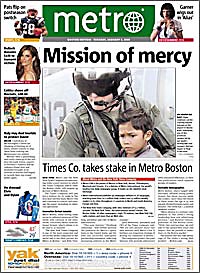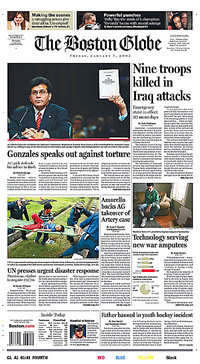
| Big Business |
 |
followthemedia.com - a knowledge base for media professionals |
|
|
AGENDA
|
||
New York Times Tries Something New: If the Young Wonít Read Its Newspaper, Then Buy Into the One They DoThe old adage goes, “If you canít beat them, join them,” and that is exactly what the New York Times Company has done in Boston in a novel experiment to see if it cannot yet still hook the youth market.The Times has bought a 49% interest in the free Metro Boston newspaper for $16 .5 million in the hope that cross promotion will persuade Metro’s young readers that as they get older to flock to the Times’ Boston Globe. It’s an interesting experiment that bears watching on the European side of the Atlantic, too. 
When the Times took over 100% ownership of the International Herald Tribune last year it started offering advertising packages for both the New York and Paris newspapers, and IHT advertising revenues are said to have increased some 30%. In what is still a very difficult US advertising climate, can similar advertising packages including The Boston Globe and Metro Boston be as successful? Can web site convergence draw young additional readers? Can Metro Boston readers, as they get older, be influenced to pay to read the actual Boston Globe newspaper rather than read the Boston news for free on its web site?
Globally, newspapers have been trying to figure out for years how they can appeal to the youth market. And then came along the free Metro and 20 Minutes transit newspapers that seemed like magnets drawing in the young with their short stories and heavy emphasis on sports and entertainment. In some countries these newspapers are circulation leaders. Several German publishers, successful in keeping those free newspapers from getting a foothold in their country, have started their own tabloids with news targeted at the young with a low kiosk price. It is still early days but while these newspapers have attracted younger readers, the circulation numbers are nothing to write home about. The Times is playing it smart. Editorial control in Metro Boston remains with the current Metro management who understand what young Bostonians want editorially. That’s a different approach to the German experiments in which the newsrooms of sister-owned newspapers of the new tabloids contribute to the editorial operation. But The Times will bring a financial punch to the Metro Boston operation and will have significant influence at the board level. Metro publishes 42 editions worldwide in 17 countries and 16 languages, but it has had a difficult time getting a strong foothold in the US where it has just three newspapers – New York, Boston and Philadelphia. Circulation is thought to be around 300,000 in New York, 180,000 in Boston, and 120,000 in Philadelphia. In several other cities publishers of existing daily newspapers have produced free newspapers to try and entice the young – and keep Metro at bay. 
Boston is a fascinating market to see if the Times can succeed. The Times owns the staid broadsheet, The Boston Globe, which has a circulation of 450,000 with little readership overlap with Metro Boston. Its prime competition is the sensational tabloid Boston Herald with circulation of about 250,000, The Herald has become increasingly sensational in the past couple of years meaning if there was ever a newspaper market with two opposites competing, then Boston is it!  Patrick J. Purcell, the Herald’s publisher claims the Times –Metro deal violates US antitrust laws and he says that he will contest it. But he will not have an easy time convincing the judiciary. The Boston media market, including the suburbs, has 18 paid newspapers and a large number of free weekly newspapers (Purcell himself bought about 100 such newspapers four years ago) and that makes it one of the most competitive in the US. This is not the first time that Metro in North America has struck such a deal. The preceding results probably give Purcell cause for worry, and there is food for thought for the Times, too.  In 2001 the Toronto Star merged its transit free newspaper, Today, with Metro’s Metro Today. Two years later and Metro’s circulation of 225,000 is beaten only by the Star’s 463,840, but the recent trend has seen Metro’s readership gain significantly while the Star has remained somewhat stable. But at the competing tabloid Toronto Sun circulation has dropped around 10% in the intervening period. More ominous for the Sun, according to the Canadian Newspaper Audience Databank, 53% of Metro readers do not read any other paid circulation dailies. If it were not for the free Metro how many of their readers would be Sun readers? Janet L. Robinson, president and chief executive of The Times, told her own newspaper she does not think the Metro Boston deal will cause circulation problems for The Boston Globe. “I think there is an opportunity for the two to mutually coexist and even to complement each other,” she said. If Boston is a success then might the Times do a similar deal on its own New York turf? There are mixed signals. In 2003 The Times turned down an opportunity to invest in what became the free newspaper amNew York. Last year Times chairman Arthur Sulzberger, Jr. criticized free newspapers as “condescending” and claimed that they talked down to the reader. With this deal he now says that not all free newspapers are the same and that Metro Boston will be a “wonderful partner”. When we see the New York Times buy into Metro in New York, we’ll know then they considered the Boston investment in enticing the young to be a success. |
| copyright ©2004-2007 ftm partners, unless otherwise noted | Contact Us • Sponsor ftm |